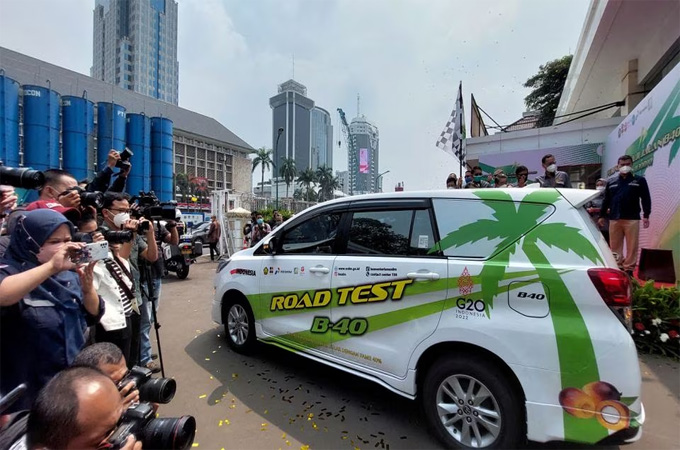
Indonesia, the world's biggest palm oil biodiesel user, is now working to introduce bioethanol mandates for gasoline to further cut fuel imports and carbon emissions, but it will first have to secure more bio feedstock and solve thorny technical problems.
Indonesia imported about 60 per cent of the gasoline it burned last year at a cost of $17 billion, and it aims to replicate the success it had with biodiesel mandates that cut billions of dollars from diesel import bills.
While much of Indonesia's emissions reductions will come from forest management and shutting coal-fired power plants, it also expects significant cuts from burning edible oil and hydrogen fuels and greater use of electric vehicles.
This year the government plans to test gasoline with 5 per cent bioethanol in Surabaya, capital of East Java province, energy ministry official Dadan Kusdiana told Reuters.
Indonesia plans eventually to mandate bioethanol content for gasoline at 15 per cent and use it nationwide by 2031, an aggressive target when it has only two bioethanol plants that struggle to secure enough sugar molasses feedstock.
"There are no technical issues for bioethanol. The issue is on the feedstock side ... If we rely on existing molasses supply, we will continue to compete (with other needs)," Dadan said.
With limited bioethanol capacity and the country relying on imported sugar to meet domestic demand, including for food, some companies are looking to produce bioethanol from other feedstocks such as cassava and biomass, possibly from palm oil kernel waste and palm trunk sap.
"There are two companies interested in producing bioethanol from biomass ... So (the programme) would not have to fully rely on sugarcane production," Dadan said.
State energy company Pertamina also plans to build a facility to produce bioethanol from cassava and mix gasoline with 5 per cent bioethanol and 15 per cent methanol for a blend it calls A20, its chief executive told a parliamentary hearing in January.
Pertamina has not said if the methanol would also have a bio source.
BIG APPETITE
Indonesia will burn 45.7 million kilolitres (12.1 billion gallons) of gasoline in 2025 and 50.1 million kl in 2030, according to a study by the Bandung Institute of Technology (ITB).
That means a 2025 mandate for 5 per cent bioethanol would require 2.29 million kl of ethanol a year, far beyond a current annual capacity for fuel grade bioethanol at 70,000 kl.
One partial answer is greater sugar output, and President Joko Widodo has announced plans to nearly quadruple land for sugar plantations to 700,000 hectares to reach sugar self-sufficiency for food and fuel in five years.
Other options are cassava-based and biomass ethanol, including from palm industry waste.
Growing demand for sugar and cassava for food, however, and the high cost of biomass ethanol are hurdles to mass adoption, said Yitian Lin, a research associate at Wood Mackenzie.
"Biomass waste can be converted to ethanol via enzyme hydrolysis or fermentation. One major advantage is that there is no competition with food. However, the technology is not yet proven at a commercial scale and costs are high," she said.
Regardless of the feedstock, subsidies similar to those given to palm biodiesel would be critical to ensure wide adoption of bioethanol, Lin said.
Dadan declined to comment when asked about subsidies, and said Indonesia is working with potential investors to get the latest technology for making biomass ethanol.
DIESEL SUCCESS
In February, Indonesia raised its mandatory biodiesel mix to 35 per cent palm oil-based content from 30 per cent in 2020. Its eight-year programme has cut diesel imports, helped turned a current account deficit to surplus and mopped up excess output resulting from the increasing difficulty in shipping palm oil to Europe.
It has also tested diesel with 40 per cent biodiesel content, and Pertamina last year started producing 3,000 barrels per day of diesel for export made entirely from palm oil.
Indonesia reduced 2022 diesel import costs by $8.34 billion via its B30 mandate and expects to save $10.75 billion this year with the B35 mandate, according to government data.
The palm industry may also help solve the bioethanol problem through biomass supply if the technology and production processes can be worked out.
Indonesia could make about 5.6 million kl of bioethanol a year from palm trunk sap alone, ITB found, based on a 4 per cent replant rate of 16 million hectares of palm plantations.
EMISSIONS AND SUPPLY CONSTRAINTS
Indonesia's energy ministry estimates overall fuel demand will grow more than 70 per cent by 2040 from 2020 levels, complicating Indonesia's aim to reach net zero emissions by 2060.
Indonesia, one of the world's biggest carbon emitters, set a target in 2022 of reducing greenhouse gas emissions by 31.89 per cent on its own by 2030 or by 43.2 per cent with international support.
Heavy reliance on biofuels is meant to help meet those targets and alleviate constraints on fuel supply caused by delays in adding new refinery capacity.
"The Indonesian government promotes alternative fuels that are commercially viable and supplement refinery production ... to cut reliance on imports because Indonesia may not see a new refinery in the next three to four years," said San Naing, a senior analyst with Fitch Solutions, part of Fitch Group. -Reuters